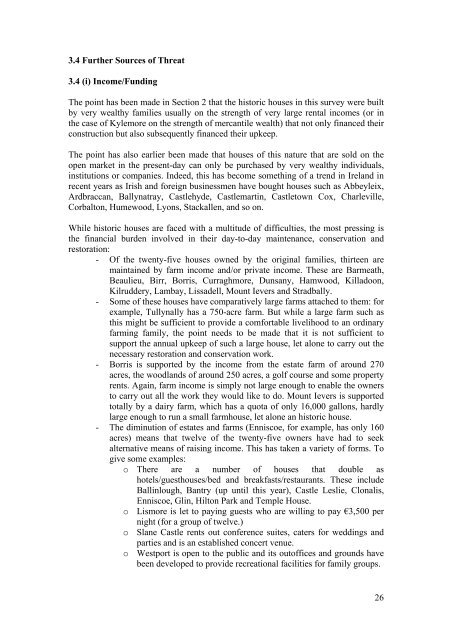A Future for Irish Historic Houses - Irish Heritage Trust
A Future for Irish Historic Houses - Irish Heritage Trust
A Future for Irish Historic Houses - Irish Heritage Trust
Create successful ePaper yourself
Turn your PDF publications into a flip-book with our unique Google optimized e-Paper software.
3.4 Further Sources of Threat<br />
3.4 (i) Income/Funding<br />
The point has been made in Section 2 that the historic houses in this survey were built<br />
by very wealthy families usually on the strength of very large rental incomes (or in<br />
the case of Kylemore on the strength of mercantile wealth) that not only financed their<br />
construction but also subsequently financed their upkeep.<br />
The point has also earlier been made that houses of this nature that are sold on the<br />
open market in the present-day can only be purchased by very wealthy individuals,<br />
institutions or companies. Indeed, this has become something of a trend in Ireland in<br />
recent years as <strong>Irish</strong> and <strong>for</strong>eign businessmen have bought houses such as Abbeyleix,<br />
Ardbraccan, Ballynatray, Castlehyde, Castlemartin, Castletown Cox, Charleville,<br />
Corbalton, Humewood, Lyons, Stackallen, and so on.<br />
While historic houses are faced with a multitude of difficulties, the most pressing is<br />
the financial burden involved in their day-to-day maintenance, conservation and<br />
restoration:<br />
- Of the twenty-five houses owned by the original families, thirteen are<br />
maintained by farm income and/or private income. These are Barmeath,<br />
Beaulieu, Birr, Borris, Curraghmore, Dunsany, Hamwood, Killadoon,<br />
Kilruddery, Lambay, Lissadell, Mount Ievers and Stradbally.<br />
- Some of these houses have comparatively large farms attached to them: <strong>for</strong><br />
example, Tullynally has a 750-acre farm. But while a large farm such as<br />
this might be sufficient to provide a com<strong>for</strong>table livelihood to an ordinary<br />
farming family, the point needs to be made that it is not sufficient to<br />
support the annual upkeep of such a large house, let alone to carry out the<br />
necessary restoration and conservation work.<br />
- Borris is supported by the income from the estate farm of around 270<br />
acres, the woodlands of around 250 acres, a golf course and some property<br />
rents. Again, farm income is simply not large enough to enable the owners<br />
to carry out all the work they would like to do. Mount Ievers is supported<br />
totally by a dairy farm, which has a quota of only 16,000 gallons, hardly<br />
large enough to run a small farmhouse, let alone an historic house.<br />
- The diminution of estates and farms (Enniscoe, <strong>for</strong> example, has only 160<br />
acres) means that twelve of the twenty-five owners have had to seek<br />
alternative means of raising income. This has taken a variety of <strong>for</strong>ms. To<br />
give some examples:<br />
o There are a number of houses that double as<br />
hotels/guesthouses/bed and breakfasts/restaurants. These include<br />
Ballinlough, Bantry (up until this year), Castle Leslie, Clonalis,<br />
Enniscoe, Glin, Hilton Park and Temple House.<br />
o Lismore is let to paying guests who are willing to pay €3,500 per<br />
night (<strong>for</strong> a group of twelve.)<br />
o Slane Castle rents out conference suites, caters <strong>for</strong> weddings and<br />
parties and is an established concert venue.<br />
o Westport is open to the public and its outoffices and grounds have<br />
been developed to provide recreational facilities <strong>for</strong> family groups.<br />
26


